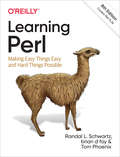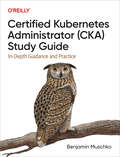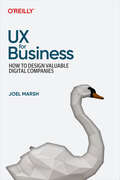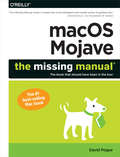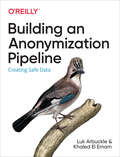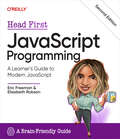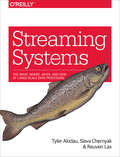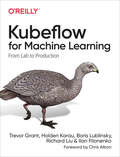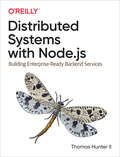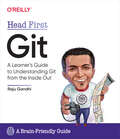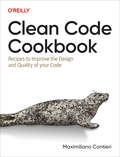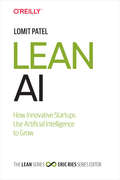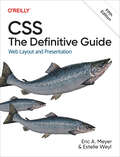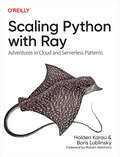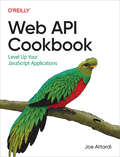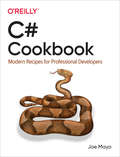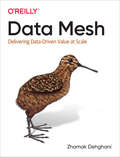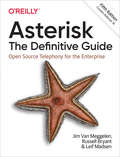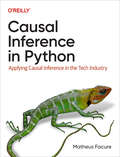- Table View
- List View
Learning Perl: Making Easy Things Easy and Hard Things Possible
by Randal L. Schwartz Tom Phoenix Brian D FoyIf you're just getting started with Perl, this is the book you want—whether you're a programmer, system administrator, or web hacker. Nicknamed "the Llama" by two generations of users, this best seller closely follows the popular introductory Perl course taught by the authors since 1991. This eighth edition covers recent changes to the language up to version 5.34.Perl is suitable for almost any task on almost any platform, from short fixes to complete web applications. Learning Perl teaches you the basics and shows you how to write simple, single-file programs—roughly 90% of the Perl programs in use today. And each chapter includes exercises to help you practice what you've just learned. Other books may teach you to program in Perl, but this book will turn you into a Perl programmer.Topics include:Perl data and variable typesSubroutinesFile operationsRegular expressionsString manipulation (including Unicode)Lists and sortingProcess managementUse of third-party modules
Learning Blazor: Build Single-Page Apps with WebAssembly and C#
by David PineTake advantage of your C# skills to build UI components and client-side experiences with .NET. With this practical guide, you'll learn how to use Blazor WebAssembly to develop next-generation web experiences. Built on top of ASP.NET Core, Blazor represents the future of .NET single-page application investments. Author David Pine, who focuses on .NET and Azure content development at Microsoft, explains how WebAssembly enables many non-JavaScript-based programming languages to run on the client browser. In this book, you'll learn about real-time web functionality with ASP.NET Core SignalR and discover strategies for bidirectional JavaScript interop. David also covers component data binding, hierarchical event-driven communications, in-memory state management, and local storage. This book shows you how to: Create a beautiful, feature-rich Blazor appDevelop and localize an enterprise-scale app using GitHub Actions and Azure Cognitive Services TranslatorCreate advanced validation scenarios for input-based components with formsAutomatically deploy and host to Azure Static Web Apps, and rely on HTTP servicesUse a geolocation service and speech synthesis and recognition native to the browserAuthor a custom modal verification mechanism for validating a user
Certified Kubernetes Administrator (CKA) Study Guide: In-Depth Guidance and Practice
by Benjamin MuschkoThe ability to administer and monitor a Kubernetes cluster is in high demand today. To meet this need, the Cloud Native Computing Foundation developed a certification exam to establish an administrator's credibility and value in the job market to confidently work in a Kubernetes environment.The Certified Kubernetes Administrator (CKA) certification exam is different from the typical multiple-choice format of other professional certifications. Instead, the CKA is a performance-based exam that requires deep knowledge of the tasks under immense time pressure.This study guide walks you through all the topics covered to fully prepare you for the exam. Author Benjamin Muschko also shares his personal experience with preparing for all aspects of the exam.Learn when and how to apply Kubernetes concepts to administer and troubleshoot a production-grade clusterUnderstand the objectives, abilities, and tips and tricks needed to pass the CKA examExplore the ins and outs of the kubectl command-line toolDemonstrate competency to perform the responsibilities of a Kubernetes administratorSolve real-world Kubernetes problems in a hands-on command-line environmentEffectively navigate and solve questions during the CKA exam
UX for Business: How to Design Valuable Digital Companies
by Joel MarshMany UX designers are surprised to learn that much of the job isn't about drawing things. It's about knowing what to draw and how to convince people to build it. Whether you're a one-person design team making products from scratch or a C-level product leader managing many products and strategies, UX for Business is your missing guide to real-world business design.You'll not only learn how to think about design as a professional but also discover how design can move the needle for your entire company. Author Joel Marsh helps you understand stakeholders, business models, the process of designing valuable solutions, dangerous choices that can ruin a product, and how to gain the attention your work deserves. You'll also explore the principles of designing common types of digital products and services, from portfolio sites to social networks to ecosystems.With this book, you'll learn:How to design the right things by understanding value, diagnostics, and probabilityHow to conduct UX research and analysis without the luxury of time or moneyThe most important aspects of common digital business modelsMethods for getting things done under less-than-ideal circumstancesHow to avoid common pitfalls caused by inexperience
Semantic Modeling for Data: Avoiding Pitfalls And Breaking Dilemmas
by Panos AlexopoulosWhat value does semantic data modeling offer? As an information architect or data science professional, let’s say you have an abundance of the right data and the technology to extract business gold—but you still fail. The reason? Bad data semantics.In this practical and comprehensive field guide, author Panos Alexopoulos takes you on an eye-opening journey through semantic data modeling as applied in the real world. You’ll learn how to master this craft to increase the usability and value of your data and applications. You’ll also explore the pitfalls to avoid and dilemmas to overcome for building high-quality and valuable semantic representations of data.Understand the fundamental concepts, phenomena, and processes related to semantic data modelingExamine the quirks and challenges of semantic data modeling and learn how to effectively leverage the available frameworks and toolsAvoid mistakes and bad practices that can undermine your efforts to create good data modelsLearn about model development dilemmas, including representation, expressiveness and content, development, and governanceOrganize and execute semantic data initiatives in your organization, tackling technical, strategic, and organizational challenges
Programming Bitcoin: Learn How to Program Bitcoin from Scratch
by Jimmy SongDive into Bitcoin technology with this hands-on guide from one of the leading teachers on Bitcoin and Bitcoin programming. Author Jimmy Song shows Python programmers and developers how to program a Bitcoin library from scratch. You’ll learn how to work with the basics, including the math, blocks, network, and transactions behind this popular cryptocurrency and its blockchain payment system.By the end of the book, you'll understand how this cryptocurrency works under the hood by coding all the components necessary for a Bitcoin library. Learn how to create transactions, get the data you need from peers, and send transactions over the network. Whether you’re exploring Bitcoin applications for your company or considering a new career path, this practical book will get you started.Parse, validate, and create bitcoin transactionsLearn Script, the smart contract language behind BitcoinDo exercises in each chapter to build a Bitcoin library from scratchUnderstand how proof-of-work secures the blockchainProgram Bitcoin using Python 3Understand how simplified payment verification and light wallets workWork with public-key cryptography and cryptographic primitives
macOS Mojave: The book that should have been in the box
by David PogueAnswers found here!Apple’s latest Mac software, macOS Mojave, is a glorious boxcar full of new features and refinements. What’s still not included, though, is a single page of printed instructions. Fortunately, David Pogue is back, delivering the expertise and humor that have made this the #1 bestselling Mac book for 18 years straight.The important stuff you need to knowBig-ticket changes. The stunning new Dark Mode. Self-tidying desktop stacks. FaceTime video calls with up to 32 people. New screen-recording tools. If Apple has it, this book covers it.Apps. This book also demystifies the 50 programs that come with the Mac, including the four new ones in Mojave: News, Stocks, Home, and Voice Memos.Shortcuts. This must be the tippiest, trickiest Mac book ever written. Undocumented surprises await on every page.Power users. Security, networking, remote access, file sharing with Windows—this one witty, expert guide makes it all crystal clear.MacOS Mojave gives the Mac more polish, power, and pep— and in your hands, you hold the ultimate guide to unlocking its potential.
Practical Salesforce Architecture: Understanding and Deploying the Salesforce Ecosystem for the Enterprise
by Paul McCollumOnce renowned as a customer relationship management tool, Salesforce has evolved into a cloud-first application and capability ecosystem. With dedicated components for tasks such as middleware, big data, reporting, ETL, data loading, and API orchestration, Salesforce has become more prevalent in modern architectures.This concise yet comprehensive guide provides an overview of Salesforce architecture for enterprise architects and Salesforce ecosystem architects. Author Paul McCollum, Salesforce Technical Architect at Accenture, provides a roadmap for integrating major elements of the Salesforce ecosystem with planned or existing enterprise architecture. You'll learn how to use these components to address the diverse needs of different organizations.Many companies today are adding or building multicloud capabilities and incorporating various elements from the Salesforce ecosystem. With this book, you'll learn:Strengths, weaknesses, and growth areas of Salesforce's enterprise architecture domain featuresHow Salesforce compares to other cloud providersMethods for using the Salesforce ecosystem effectively to address your organization's needsHow to integrate Salesforce with planned or existing enterprise architecturesWays to manage and forecast performance, complexity, and ease of operation across the Salesforce platform
Building an Anonymization Pipeline: Creating Safe Data
by Luk Arbuckle Khaled El EmamHow can you use data in a way that protects individual privacy but still provides useful and meaningful analytics? With this practical book, data architects and engineers will learn how to establish and integrate secure, repeatable anonymization processes into their data flows and analytics in a sustainable manner.Luk Arbuckle and Khaled El Emam from Privacy Analytics explore end-to-end solutions for anonymizing device and IoT data, based on collection models and use cases that address real business needs. These examples come from some of the most demanding data environments, such as healthcare, using approaches that have withstood the test of time.Create anonymization solutions diverse enough to cover a spectrum of use casesMatch your solutions to the data you use, the people you share it with, and your analysis goalsBuild anonymization pipelines around various data collection models to cover different business needsGenerate an anonymized version of original data or use an analytics platform to generate anonymized outputsExamine the ethical issues around the use of anonymized data
Head First JavaScript Programming: A Learner's Guide to Modern JavaScript
by Eric Freeman Elisabeth RobsonWhat will you learn from this book?The new edition of this brain-friendly guide takes you through a comprehensive journey into modern JavaScript, covering everything from core language fundamentals to today's cutting-edge features. You'll dive into the nuances of JavaScript types and the unparalleled flexibility of its functions. You'll also learn how to expertly navigate classes and objects, and finally understand closures. But that's just the beginning. You'll also get hands-on with the browser's document object model (DOM), engaging with JavaScript in exciting ways. You won't just be reading—you'll be playing games, solving puzzles, pondering mysteries, and interacting with JavaScript as never before. And you'll write real code, lots of it, so you can start building your own applications.What's so special about this book?If you've read a Head First book, you know what to expect: a visually rich format designed for the way your brain works. If you haven't, you're in for a treat. With this book, you'll learn JavaScript through a multisensory experience that engages your mind—rather than a text-heavy approach that puts you to sleep.
Practical MLOps: Operationalizing Machine Learning Models
by Noah Gift Alfredo DezaGetting your models into production is the fundamental challenge of machine learning. MLOps offers a set of proven principles aimed at solving this problem in a reliable and automated way. This insightful guide takes you through what MLOps is (and how it differs from DevOps) and shows you how to put it into practice to operationalize your machine learning models.Current and aspiring machine learning engineers--or anyone familiar with data science and Python--will build a foundation in MLOps tools and methods (along with AutoML and monitoring and logging), then learn how to implement them in AWS, Microsoft Azure, and Google Cloud. The faster you deliver a machine learning system that works, the faster you can focus on the business problems you're trying to crack. This book gives you a head start.You'll discover how to:Apply DevOps best practices to machine learningBuild production machine learning systems and maintain themMonitor, instrument, load-test, and operationalize machine learning systemsChoose the correct MLOps tools for a given machine learning taskRun machine learning models on a variety of platforms and devices, including mobile phones and specialized hardware
Streaming Systems: The What, Where, When, and How of Large-Scale Data Processing
by Tyler Akidau Slava Chernyak Reuven LaxStreaming data is a big deal in big data these days. As more and more businesses seek to tame the massive unbounded data sets that pervade our world, streaming systems have finally reached a level of maturity sufficient for mainstream adoption. With this practical guide, data engineers, data scientists, and developers will learn how to work with streaming data in a conceptual and platform-agnostic way.Expanded from Tyler Akidau’s popular blog posts "Streaming 101" and "Streaming 102", this book takes you from an introductory level to a nuanced understanding of the what, where, when, and how of processing real-time data streams. You’ll also dive deep into watermarks and exactly-once processing with co-authors Slava Chernyak and Reuven Lax.You’ll explore:How streaming and batch data processing patterns compareThe core principles and concepts behind robust out-of-order data processingHow watermarks track progress and completeness in infinite datasetsHow exactly-once data processing techniques ensure correctnessHow the concepts of streams and tables form the foundations of both batch and streaming data processingThe practical motivations behind a powerful persistent state mechanism, driven by a real-world exampleHow time-varying relations provide a link between stream processing and the world of SQL and relational algebra
Kubeflow for Machine Learning
by Holden Karau Boris Lublinsky Trevor Grant Richard Liu Ilan FilonenkoIf you're training a machine learning model but aren't sure how to put it into production, this book will get you there. Kubeflow provides a collection of cloud native tools for different stages of a model's lifecycle, from data exploration, feature preparation, and model training to model serving. This guide helps data scientists build production-grade machine learning implementations with Kubeflow and shows data engineers how to make models scalable and reliable.Using examples throughout the book, authors Holden Karau, Trevor Grant, Ilan Filonenko, Richard Liu, and Boris Lublinsky explain how to use Kubeflow to train and serve your machine learning models on top of Kubernetes in the cloud or in a development environment on-premises.Understand Kubeflow's design, core components, and the problems it solvesUnderstand the differences between Kubeflow on different cluster typesTrain models using Kubeflow with popular tools including Scikit-learn, TensorFlow, and Apache SparkKeep your model up to date with Kubeflow PipelinesUnderstand how to capture model training metadataExplore how to extend Kubeflow with additional open source toolsUse hyperparameter tuning for trainingLearn how to serve your model in production
Distributed Systems with Node.js
by Thomas Hunter IIMany companies, from startups to Fortune 500 companies alike, use Node.js to build performant backend services. And engineers love Node.js for its approachable API and familiar syntax. Backed by the world's largest package repository, Node's enterprise foothold is only expected to grow.In this hands-on guide, author Thomas Hunter II proves that Node.js is just as capable as traditional enterprise platforms for building services that are observable, scalable, and resilient. Intermediate to advanced Node.js developers will find themselves integrating application code with a breadth of tooling from each layer of a modern service stack.Learn why running redundant copies of the same Node.js service is necessaryKnow which protocol to choose, depending on the situationFine-tune your application containers for use in productionTrack down errors in a distributed setting to determine which service is at faultSimplify app code and increase performance by offloading work to a reverse proxyBuild dashboards to monitor service health and throughputFind out why so many different tools are required when operating in an enterprise environment
Head First Git: A Learner's Guide to Understanding Git from the Inside Out
by Raju GandhiWhat will you learn from this book?Many people who use Git rely on "recipes"--copying and pasting commands they find on the internet without really understanding how Git actually works. But what do you do if you find yourself in a tight spot? You can't simply wing it. With this unique hands-on guide, you'll learn the ways of Git and have fun while doing it. Raju Gandhi peels back the layers to reveal the simple yet powerful engine that powers Git, so you'll understand not just the how but the why. You'll master branches, merges, commit messages, search, utilities, and more; learn best practices for collaborative work; and unlock the full potential of Git.What's so special about this book?If you've read a Head First book, you know what to expect--a visually rich format designed for the way your brain works. If you haven't, you're in for a treat. With this book, you'll learn Git through a multisensory experience that engages your mind rather than a text-heavy approach that puts you to sleep.
Clean Code Cookbook: Recipes to Improve the Design and Quality of your Code
by Maximiliano ContieriOften, software engineers and architects work with large, complex code bases that they need to scale and maintain. With this cookbook, author Maximiliano Contieri takes you beyond the concept of clean code by showing you how to identify improvement opportunities and their impact on production code. When it comes to reliability and system evolution, these techniques provide benefits that pay off over time.Using real life examples in JavaScript, PHP, Java, Python, and many other programming languages, this cookbook provides proven recipes to help you scale and maintain large systems. Every section covers fundamental concepts including readability, coupling, testability, and extensibility, as well as code smells—symptoms of a problem that requires special attention—and the recipes to address them.As you proceed through this book, refactoring recipes and the variety of code smells increase in complexity. You will:Understand the benefits of clean code and learn how to detect code smellsLearn refactoring techniques step by stepGain illustrative code examples in several modern programming languagesGet a comprehensive catalog of common code smells, their impacts, and possible solutionsUse code that's straight to the point, favoring readability and learning
Lean AI: How Innovative Startups Use Artificial Intelligence to Grow
by Lomit PatelHow can startups successfully scale customer acquisition and revenue growth with a Lean team? Out-of-the-box acquisition solutions from Facebook, Google, and others provide a good start, but the companies that can tailor those solutions to meet their specific needs, objectives, and goals will come out winners. But that hasn’t been an easy task—until now.With this practical book, author Lomit Patel shows you how to use AI and automation to provide an operational layer atop those acquisition solutions to deliver amazing results for your company. You’ll learn how to adapt, customize, and personalize cross-channel user journeys to help your company attract and retain customers—to usher in the new age of Autonomous Marketing.Learn how AI and automation can support the customer acquisition efforts of a Lean StartupDive into Customer Acquisition 3.0, an initiative for gaining and retaining customersExplore ways to use AI for marketing purposesUnderstand the key metrics for determining the growth of your startupDetermine the right strategy to foster user acquisition in your companyManage the increased complexity and risk inherent in AI projects
CSS: Web Layout and Presentation
by Eric Meyer Estelle WeylIf you're a web designer or app developer interested in sophisticated page styling, improved accessibility, and less time and effort expended, this book is for you. This revised fifth edition provides a comprehensive guide to CSS implementation along with a thorough review of the latest CSS specifications.Authors Eric Meyer and Estelle Weyl show you how to improve user experience, speed development, avoid potential bugs, and add life and depth to your applications through layout, transitions and animations, borders, backgrounds, text properties, and many other tools and techniques. We read the specs so you don't have to!This guide covers:Selectors, specificity, and the cascade, including information on the new cascade layersNew and old CSS values and units, including CSS variables and ways to size based on viewportsDetails on font technology and ways to use any available font variantsText styling, from basic decoration to changing the entire writing modePadding, borders, outlines, and margins, now discussed in terms of the new block- and inline-direction layout paradigm used by modern browsersColors, backgrounds, and gradients, including the conic gradientsAccessible data tablesFlexible box and grid layout systems, including new subgrid capabilities2D and 3D transforms, transitions, and animationFilters, blending, clipping, and maskingMedia, feature, and container queries
Scaling Python with Ray: Adventures in Cloud and Serverless Patterns
by Holden Karau Boris LublinskyServerless computing enables developers to concentrate solely on their applications rather than worry about where they've been deployed. With the Ray general-purpose serverless implementation in Python, programmers and data scientists can hide servers, implement stateful applications, support direct communication between tasks, and access hardware accelerators.In this book, experienced software architecture practitioners Holden Karau and Boris Lublinsky show you how to scale existing Python applications and pipelines, allowing you to stay in the Python ecosystem while reducing single points of failure and manual scheduling. Scaling Python with Ray is ideal for software architects and developers eager to explore successful case studies and learn more about decision and measurement effectiveness.If your data processing or server application has grown beyond what a single computer can handle, this book is for you. You'll explore distributed processing (the pure Python implementation of serverless) and learn how to:Implement stateful applications with Ray actorsBuild workflow management in RayUse Ray as a unified system for batch and stream processingApply advanced data processing with RayBuild microservices with RayImplement reliable Ray applications
Web API Cookbook: Level Up Your JavaScript Applications
by Joe AttardiJavaScript gives web developers great power to create rich interactive browser experiences, and much of that power is provided by the browser itself. Modern web APIs enable web-based applications to come to life like never before, supporting actions that once required browser plug-ins. Some are still in an experimental stage, but many are ready for use today.With this hands-on cookbook, author Joe Attardi helps you explore the powerful APIs available in modern browsers and guides you through the specific tasks that they unlock. Because these features are web standards, there is comprehensive documentation available from trusted resources such as MDN Web Docs. The knowledge you'll gain is transferable across different companies and projects.Learn the breadth of functionality available in modern browser APIsExplore future APIs that are still in an experimental stageDiscover newer elements, such as dialog that replaces the need for a third-party libraryBuild more powerful and interactive web applications using native APIsUnderstand the permissions model used by the browser to unlock functionality such as geolocation and push notifications
C# Cookbook: Modern Recipes for Professional Developers
by Joe MayoEven if you're familiar with C# syntax, knowing how to combine various language features is a critical skill when you're building applications. This cookbook is packed full of recipes to help you solve issues for C# programming tasks you're likely to encounter. You'll learn tried-and-true techniques to help you achieve greater productivity and improve the quality of your code.Author and independent consultant Joe Mayo shares some of the most important practices you'll need to be successful as a C# developer. Each section of this cookbook describes some useful facet of the C# programming language. These recipes--the result of many years of experience--are proven concepts for solving real-world problems with C#.Recipes in this book will help you:Set up your project, manage object lifetime, and establish patternsImprove code quality through maintainability, error prevention, and correct syntaxUse LINQ to Objects for in-memory data manipulation and queryingUnderstand the differences between dynamic programming and reflectionApply several async programming features you may not be aware ofWork with data using newer libraries and algorithmsLearn different ways to use new C# features, such as pattern matching and records
Data Mesh: Delivering Data-Driven Value at Scale
by Zhamak DehghaniWe're at an inflection point in data, where our data management solutions no longer match the complexity of organizations, the proliferation of data sources, and the scope of our aspirations to get value from data with AI and analytics. In this practical book, author Zhamak Dehghani introduces data mesh, a decentralized sociotechnical paradigm drawn from modern distributed architecture that provides a new approach to sourcing, sharing, accessing, and managing analytical data at scale.Dehghani guides practitioners, architects, technical leaders, and decision makers on their journey from traditional big data architecture to a distributed and multidimensional approach to analytical data management. Data mesh treats data as a product, considers domains as a primary concern, applies platform thinking to create self-serve data infrastructure, and introduces a federated computational model of data governance.Get a complete introduction to data mesh principles and its constituentsDesign a data mesh architectureGuide a data mesh strategy and executionNavigate organizational design to a decentralized data ownership modelMove beyond traditional data warehouses and lakes to a distributed data mesh
Learning MySQL: Get a Handle on Your Data
by Vinicius M. Grippa Sergey KuzmichevGet a comprehensive overview on how to set up and design an effective database with MySQL. This thoroughly updated edition covers MySQL's latest version, including its most important aspects. Whether you're deploying an environment, troubleshooting an issue, or engaging in disaster recovery, this practical guide provides the insights and tools necessary to take full advantage of this powerful RDBMS.Authors Vinicius Grippa and Sergey Kuzmichev from Percona show developers and DBAs methods for minimizing costs and maximizing availability and performance. You'll learn how to perform basic and advanced querying, monitoring and troubleshooting, database management and security, backup and recovery, and tuning for improved efficiency. This edition includes new chapters on high availability, load balancing, and using MySQL in the cloud.Get started with MySQL and learn how to use it in productionDeploy MySQL databases on bare metal, on virtual machines, and in the cloudDesign database infrastructuresCode highly efficient queriesMonitor and troubleshoot MySQL databasesExecute efficient backup and restore operationsOptimize database costs in the cloudUnderstand database concepts, especially those pertaining to MySQL
Asterisk: Open Source Telephony for the Enterprise
by Leif Madsen Jim Van Meggelen Russell BryantDesign a complete Voice over IP (VoIP) or traditional PBX system with Asterisk, even if you have only basic telecommunications knowledge. This bestselling guide makes it easy with a detailed roadmap that shows you how to install and configure this open source software, whether you’re upgrading your existing phone system or starting from scratch.Ideal for Linux administrators, developers, and power users, this updated fifth edition shows you how to set up VoIP-based private telephone switching systems within the enterprise. You’ll get up to speed on the features in Asterisk 16, the latest long-term support release from Digium. This book also includes new chapters on WebRTC and the Asterisk Real-time Interface (ARI).Discover how WebRTC provides a new direction for AsteriskGain the knowledge to build a simple but complete phone systemBuild an interactive dialplan, using best practices for Asterisk’s advanced featuresLearn how ARI has emerged as the API of choice for interfacing web development languages with Asterisk
Causal Inference in Python: Applying Causal Inference in the Tech Industry
by Matheus FacureHow many buyers will an additional dollar of online marketing bring in? Which customers will only buy when given a discount coupon? How do you establish an optimal pricing strategy? The best way to determine how the levers at our disposal affect the business metrics we want to drive is through causal inference.In this book, author Matheus Facure, senior data scientist at Nubank, explains the largely untapped potential of causal inference for estimating impacts and effects. Managers, data scientists, and business analysts will learn classical causal inference methods like randomized control trials (A/B tests), linear regression, propensity score, synthetic controls, and difference-in-differences. Each method is accompanied by an application in the industry to serve as a grounding example.With this book, you will:Learn how to use basic concepts of causal inferenceFrame a business problem as a causal inference problemUnderstand how bias gets in the way of causal inferenceLearn how causal effects can differ from person to personUse repeated observations of the same customers across time to adjust for biasesUnderstand how causal effects differ across geographic locationsExamine noncompliance bias and effect dilution
